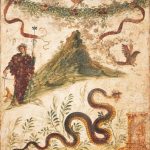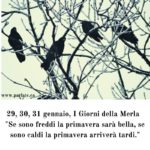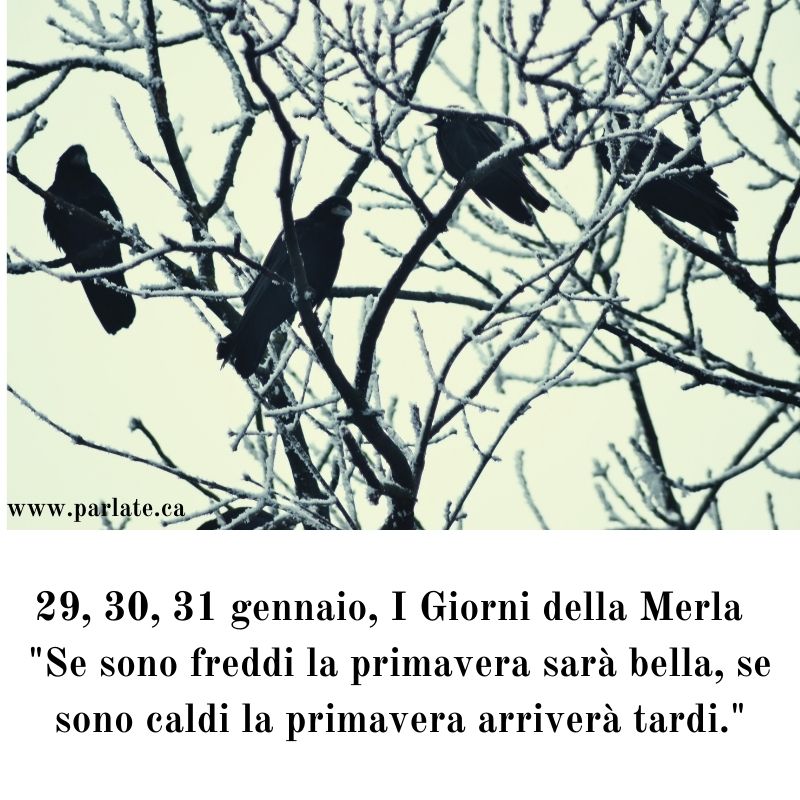English follows
La leggenda italiana narra che gli ultimi giorni di gennaio, i giorni della merla, siano i più freddi dell’anno. Se le giornate del 29, 30 e 31 gennaio sono particolarmente fredde, la primavera dovrebbe essere calda e soleggiata e arrivare presto. In caso contrario, la primavera sarà tardiva e piovosa. Ma come sappiamo, non sempre è così. Esistono tante storie legate a questa leggenda popolare che coinvolgono tutte la merla e gli ultimi giorni di gennaio.
La versione più popolare racconta la storia antica di una merla bianca. Al tempo pare che i merli avessero tutti le piume bianche. La merla tormentata da un gennaio dispettoso, che all’epoca aveva 28 giorni mentre febbraio ne aveva 31, era costretta a cercare un riparo più sicuro dal freddo.
La merla trovò rifugio accanto al tiepido comignolo di una casa. Ogni volta che la povera merla lasciava il nido per cercare cibo, il malizioso gennaio le si avventava addosso con neve, temperature frigide e una brezza gelida.
Il gennaio successivo la merla decise di fare scorta di cibo e di rimanere nel suo nido per 28 giorni prima di emergere trionfante per cantare e stuzzicare gennaio. Per vendetta, il mese di gennaio risentito ha allora preso in prestito tre giorni da febbraio scatenando una violenta tempesta di neve e costringendo la merla a nascondersi ancora una volta.
L’uccello si rifugiò in un comignolo, dove rimase per tre giorni, e quando emerse il 1° febbraio le sue candide piume erano diventate per sempre nere di fuliggine. Da quel momento in poi tutti i merli avrebbero avuto le piume scure.
E nacque così la leggenda dei Giorni della Merla.
❄️
The Italian Legend has it that the last days of January, “I Giorni della Merla”, the days of the blackbird, are the coldest of the year. If the days of January 29th, 30th and 31st are particularly cold, spring should be warm and sunny and should come early. Otherwise, spring will be late and rainy. But as we know, this is not always the case. There are many stories related to this popular legend that all involve the blackbird and the last days of January.
The most popular version tells the ancient story of a white blackbird, una merla bianca. At the time it seems that the blackbirds all had white feathers. The blackbird tormented by a spiteful January, which at the time was 28 days long while February had 31 days, was forced to seek a safer shelter from the cold.
The blackbird found refuge next to the warm chimney of a house. Whenever the poor blackbird left the nest to look for food, the mischievous January pounced on it with snow, frigid temperatures and a freezing breeze.
The following January the blackbird decided to stock up on food and stay in its nest for 28 days before emerging triumphant to sing and tease January. In revenge, the resentful month of January borrowed three days from February unleashing a violent snowstorm and forcing the blackbird into hiding once again.
The bird took refuge in a chimney, where it remained for three days, and by the time it emerged on February 1st, its white feathers were forever black with soot. From then on, all blackbirds would have dark feathers.
And thus the legend of the,“Giorni della Merla”, the Days of the Blackbird was born.
- Virtual travel in Trentino-Alto Adige – Travelling in Italy

- Villaggi intelligenti – Smart Villages | Italian Home

- Un viaggio virtuale in Valle d’Aosta

- Un viaggio virtuale in Campania – Travelling to Campania

- Un viaggio virtuale in Abruzzo

- Top Italian articles of the year | Gli articoli migliori dell’anno

- The year of Dante 2021 | Take the quiz on Dante and the Divine Comedy

- The language of wine between art and taste

- The Days of the Blackbird-Italian legend | I Giorni della Merla


